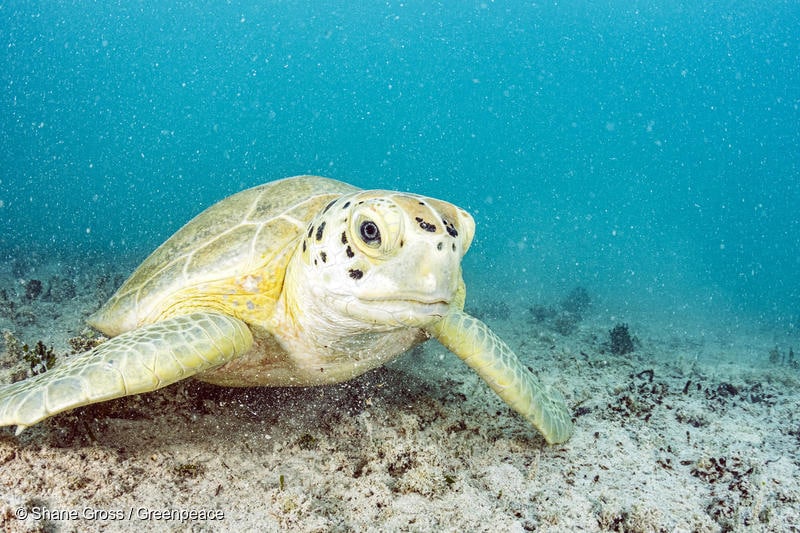The Inside Story of ‘the Largest Conservation Agreement in the History of the World’

 Why you can trust us
Why you can trust us
Founded in 2005 as an Ohio-based environmental newspaper, EcoWatch is a digital platform dedicated to publishing quality, science-based content on environmental issues, causes, and solutions.
On Saturday, March 4, world leaders finally agreed on a treaty to protect the high seas.
The accord reached by the Intergovernmental Conference on Marine Biodiversity of Areas Beyond National Jurisdiction establishes a mechanism for sharing the benefits of scientific discoveries from marine life, enforces environmental impact assessments for new human activities in international waters and makes it possible to create protected areas in the open ocean.
“It’s going to provide first-time protections ever for half of the planet that has not ever had that,” Greenpeace USA senior oceans campaigner Arlo Hemphill told EcoWatch in an email. “And that makes it the largest conservation agreement in the history of the world.”
It’s also not one that was reached easily. The final agreement is the work of more than a decade of formal negotiations and two decades of political mobilization. Hemphill spoke with EcoWatch about why it took so long and what finally eased its passage through the rough waters of international discord.
Running Aground
When the idea of a high seas treaty was first broached two decades ago, protecting international biodiversity was not on the radar of world leaders. There was also a significant amount of resistance from the fishing industry.
“Just the very idea of this was a threat to global fishery corporations,” Hemphill said.
However, as negotiations first began and then stalled, one key issue emerged as the sticking point: how to share the benefits of Marine Genetic Resources (MGRs), or any new medicines, foods, textiles or other innovations derived from lifeforms discovered in international waters. Countries from the Global South were justifiably concerned that wealthy corporations and countries in the Global North would be the only ones to profit from such discoveries.
The question, Hemphill explained, was “how we’re going to implement something that is considered the common heritage of humankind, meaning it belongs to every person, in a way that was equitable to the 85 percent of the planet that doesn’t have the resources to be out there studying things.”
That said, the Global North was concerned that a true profit-sharing agreement would generate so much bureaucracy that companies would be disincentivized to do any research. Further, it could take 10 to 15 years before any research actually led to a product that could make money.
The breakthrough came with a proposal from the Global North to offer money from any potential discoveries up front to fund the implementation of the treaty, help poorer nations establish marine sanctuaries and pay for their delegates to attend future meetings.
‘The Ship Has Reached the Shore’
The Global North first offered a payment package at the end of negotiations in August of 2022, but it did so at the last minute.
“Countries did not have the bandwidth to take the proposal back to their capitals and get an answer by the end of the week,” Hemphill said.
That money was on the table when negotiations began again on Feb. 20 of 2023, but still, during the second and last week of negotiations, it looked like countries might fail to reach a deal.
“The future of half our planet is at stake and yet negotiations have been progressing at a snail’s pace, and this is reflected in the new draft Treaty text,” Greenpeace’s Co-Executive Director Will McCallum told EcoWatch in an email Feb. 28. “With major setbacks impacting its ability to create marine protected areas in our global oceans and Global North countries like the UK, U.S. and European Union member states refusing to seek compromises on other areas we need to see a step change in pace in the coming three days.”
What made that change possible, according to Hemphill’s account, was the leadership of Conference President Rena Lee of Singapore, who held one-on-one meetings with the most stubborn national delegations.
“She basically brought these people one by one in meetings that were happening around the clock all through Friday night, all into Saturday,” he said.
By 9:30 p.m. on Saturday, she said that there was an agreement with enough votes to pass.
“Ladies and gentlemen, the ship has reached the shore,” she announced Saturday night on UN Web TV.
The U.S. Changes Tack
Another factor that helped ease negotiations was the role of the U.S., which was an obstacle to progress under former Presidents Donald Trump and even Barack Obama, but emerged as a leader under the administration of current President Joe Biden.
“I thought the U.S., which was really a terrible player in this, really came through at the end and brought things through in a really special way that made me proud to be an American citizen for once,” Hemphill said.
Hemphill singled out Assistant Secretary of State for Oceans and International Environmental and Scientific Affairs Monica Medina, who had made it a priority to see a treaty negotiated during her tenure and saw it through to the bitter end. Hemphill saw her sleeping on a couch outside the conference room at 3 a.m. during the last days of negotiations. Medina herself applauded the outcome of the negotiations.
“Today the world came together to protect the ocean for the benefit of our children and grandchildren. We leave here with the ability to create protected areas in the high seas and achieve the ambitious goal of conserving 30 percent of the ocean by 2030,” Medina said in a statement on Twitter. “And the time to start is now.”
30 by 30
Another factor that helped clinch Saturday’s agreement was the fact that the world had already agreed to protect 30 percent of land and waters by 2030 during the COP15 UN Biodiversity Conference in Montreal in December of 2022.
“It totally changed the tone,” Hemphill said.
During previous negotiations, countries that opposed the 30 by 30 target could point to a lack of agreement on the goal to oppose conservation measures.
“If we had not gotten the 30 by 30 agreement in Montreal, we would have been in a very weak position coming in here,” Hemphill said.
The target and the treaty have a sort of symbiotic relationship, because negotiators were also aware it would be difficult for their nations to meet their 30 by 30 commitments without a robust agreement.
‘If this treaty had not been agreed upon, it would have just literally been impossible to get to 30 percent without being able to create sanctuaries in international waters,” Hemphill said.
All Hands on Deck
Bolstering the more ambitious negotiators were the voices of concerned ocean lovers and activist groups like Greenpeace that had organized for a successful treaty.
As a member of the High Seas Alliance, Greenpeace both lobbied government negotiators and mobilized the public through a “Protect the Oceans” ship tour researching and highlighting ocean places in need of protection, days of action bringing ocean imagery to major cities and a petition that garnered nearly six million signatures. During the last round of negotiations, Greenpeace members staged an art occupation of beach plastic marine animals and chalk seascapes outside the UN.
“WE DID IT!” actor and activist Jane Fonda, who participated in a Greenpeace press briefing ahead of the most recent negotiations, tweeted when the deal was announced. “Yesterday, on March 4th, 2023, after years of talks, delay and emotional rollercoaster, governments finally concluded a Global Ocean Treaty!!! I am so grateful for everyone, including @Greenpeace, who helped to make this historic win possible.”
Sailing On
Environmental groups like Greenpeace do not plan to rest in the harbor just because negotiations have wrapped. The treaty now has to be ratified by at least 60 member states, and the next goal of activists is to push for the protection of particular high seas ecosystems. One promising candidate is the Sargasso Sea, since the governments of Bermuda, the U.S., Canada, the UK and other Caribbean nations are already in talks to protect it.
As part of its Protect the Oceans tour, Greenpeace took University of Florida scientists to the sea to test the hypothesis that the mats of sargassum algae that give it its name could act as an incubator for baby sea turtles.

“We went around and took measurements inside and outside the sargassum mats and found very distinct and consistent temperature differences that are most likely helping accelerate the growth of baby sea turtles so they can get beyond that fragile stage,” Hemphill said.
Other candidates for protection include the Costa Rica Dome, the Emperor Seamounts in the North Pacific and Walvis Ridge off the coast of Namibia.
Another pressing ocean issue that the treaty might help with is deep-sea mining. It won’t be in place in time to do anything about the fact that the two-year rule has been triggered, which means the UN’s International Seabed Authority has to either establish new regulations or allow mining to proceed under existing rules by July of this year. However, in the future it may be able to mitigate the impacts of extracting minerals from the seabed.
“Theoretically, deep sea mining should be under a higher standard of environmental impact assessments after this treaty, and there would be the capacity to build ocean sanctuaries… in places that are already of interest to deep sea miners,” Hemphill said.
Subscribe to get exclusive updates in our daily newsletter!
By signing up, you agree to the Terms of Use and Privacy Policy & to receive electronic communications from EcoWatch Media Group, which may include marketing promotions, advertisements and sponsored content.

 233k
233k  41k
41k  Subscribe
Subscribe 




